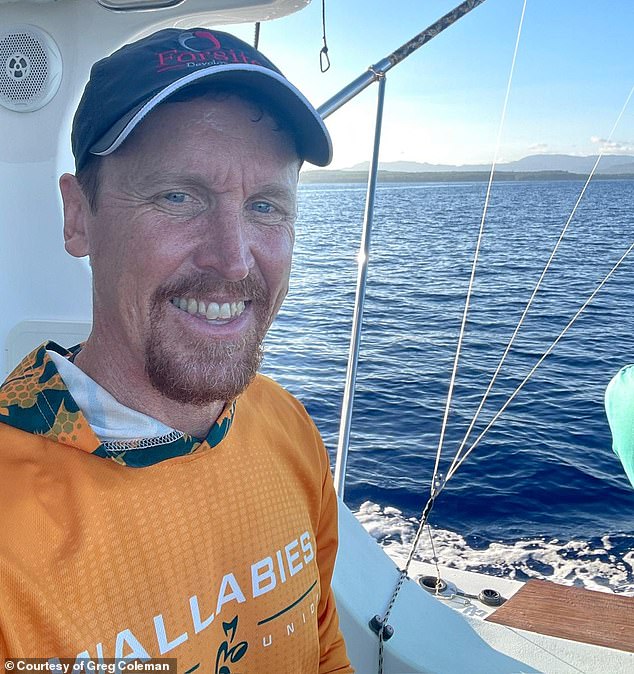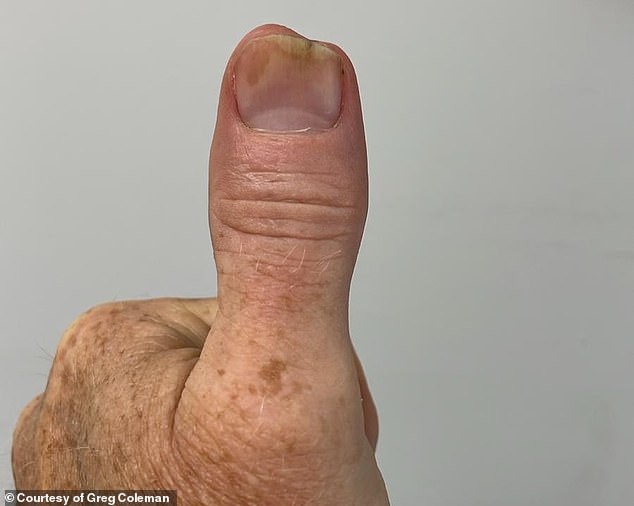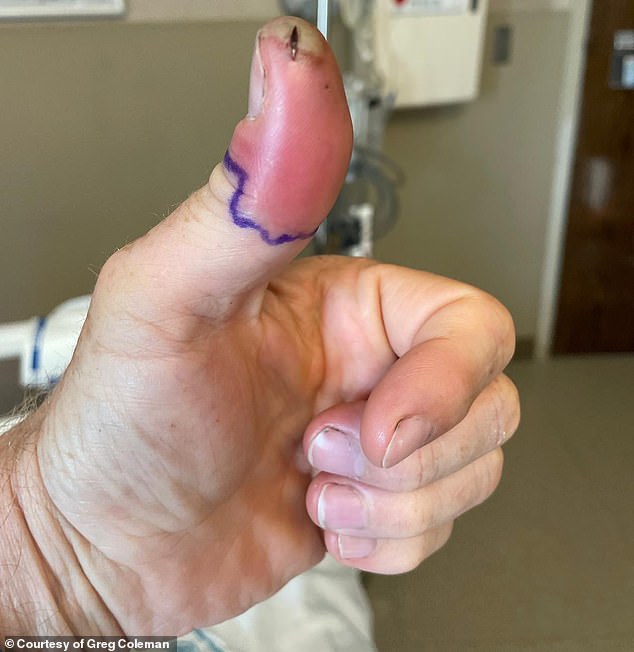A relaxing trip to a North Carolina beach turned into a nightmare for a man after he cut his thumb on a piece of wire in the sand and developed a flesh-eating bacterial infection.
Greg Coleman, 53, was at Topsail Beach, where he was trying to make a wire strainer so his wife could search for prehistoric shark teeth, which are known to appear in the area.
While the maintenance crew was building the tool, he suffered several cuts and scratches on his hands, but he didn’t think anything of it.
However, two days after his visit to the beach on August 18, he noticed that one of the small cuts on his thumb “exploded and it hurt really, really bad.”
It wasn’t long after that Coleman was rushed to the hospital with an infection caused by drug-resistant bacteria that required the tip of his thumb to be amputated.
Greg Coleman, 53, was at Topsail Beach in North Carolina when he suffered a small cut on his thumb that steadily worsened.
Detailing the chain of events, he said: ‘The infection started running from my arm to my shoulder.
‘I became increasingly concerned about the condition of my thumb and sought medical attention.
‘At first, I made a virtual visit to the doctor to get some antibiotics, but no one knew what it was or how to treat it.
‘However, the pain continued to increase and on August 22 I went to the emergency room where they gave me an injection of antibiotics and some more pills.
“Only two days after that, I had to rush to the emergency room, where they admitted me and prescribed me intravenous antibiotics.”
The 53-year-old believes he contracted MRSA, or methicillin-resistant Staphylococcus aureus, a drug-resistant bacteria that may have entered his bloodstream on the beach through a minor cut on his thumb.
Since the hospital never performed a culture test to see what it was, it is unclear whether Mr. Coleman had MRSA, but he showed common MRSA symptoms and doctors also suspected it was a bacterial skin infection.
Staphylococcus aureus (staph) is a common germ that many people have in their bodies, but MRSA is a type of staph that is resistant to common antibiotics. This makes it difficult to treat and can cause major health complications.
MRSA infections usually begin at the site of cuts, scrapes, or broken skin and initially appear as a lump, but develop into painful, red, swollen areas that may be filled with pus.
Severe cases of MRSA can cause pneumonia, sepsis, necrotizing fasciitis (an infection that kills body tissues), and death.
While the bacteria is resistant to common antibiotics, there are several others that have been shown to be effective, and surgery is usually required to eliminate the entire infection.
MRSA occurs most frequently in hospitalized patients and affects approximately 1.2 million people per year.
Coleman, who runs a small renewable gas power plant in North Carolina, said he had “never experienced pain like this” when the infection began, and felt like his thumb was being “hit with a hammer over and over again.”
After receiving 11 different antibiotics, most of the infection was cleared a month later.
However, the father-of-two experienced even more severe symptoms in late September when the bacteria traveled through his bloodstream and invaded his thumb bone.
To prevent the infection from spreading further, he was rushed into surgery, where doctors had to cut out the infected bone.

Now Coleman says the wound is mostly healed, but he’ll be more careful the next time he goes to the beach.

The bacterial infection entered Mr Coleman’s thumb bone, so the tip had to be removed.
Although he didn’t lose his entire thumb, Coleman was left with a dent in the tip.
Now, Coleman says the wound is mostly healed and the infection is almost gone, but he’ll be more careful the next time he goes to the beach.
He added: ‘I heard about another lady who had a scratch on her leg who also became infected with MRSA the same week and after visiting the same beach.
‘As a child I grew up on a farm and ran around all the time without shoes and I lived in Africa for a year as an adult where I did the same. I always got small cuts on my feet, but everything healed in the past.
“So it seems silly that I would get stuck with a new wire in a first world country and seek medical help and it would all go so wrong.”
“If this had happened abroad when I was younger, I definitely would have had to cut off my thumb to save myself.”
MRSA isn’t the only bacteria lurking on U.S. beaches. Over the past year, the deadly flesh-eating bacteria Vibrio vulnificus has been detected on beaches up and down the East Coast; off the coast of Long Island in Connecticut, on beaches and seafood restaurants in Florida, and more.
Vibrio cases spiked, sickening 11 people in three states last summer: North Carolina, New York and Connecticut. The average age of the patients was 70 years. Four people suffered septic shock and five died.
All but one of those exposures were related to exposure of the wounds to natural bodies of water.
Dr. Lisa Plano of the University of Miami Miller School of Medicine says that to avoid bacterial infections at the beach, it’s best to shower before and after getting in the water.
And, if you have an open wound, it’s best to avoid the beach altogether or make sure to properly bandage existing scrapes and cuts.


